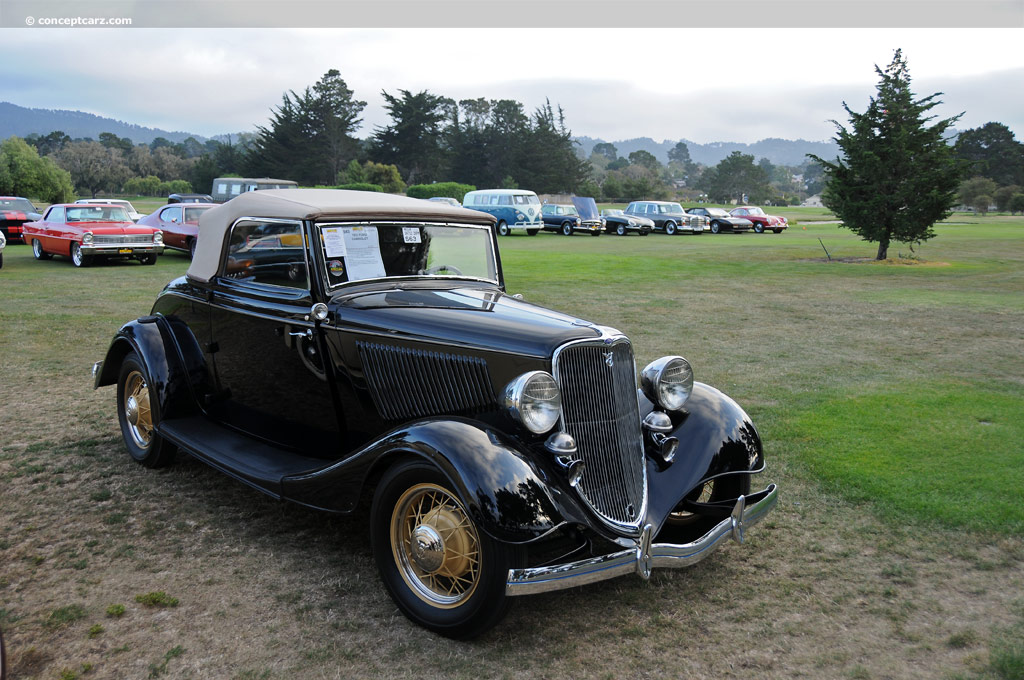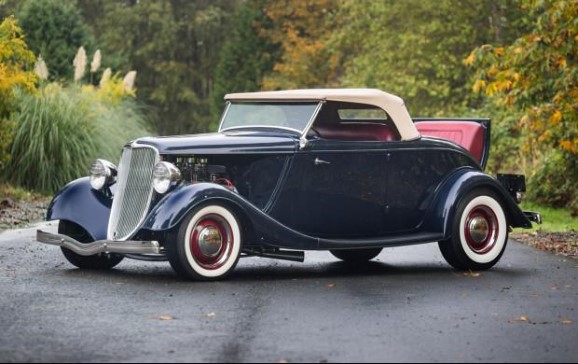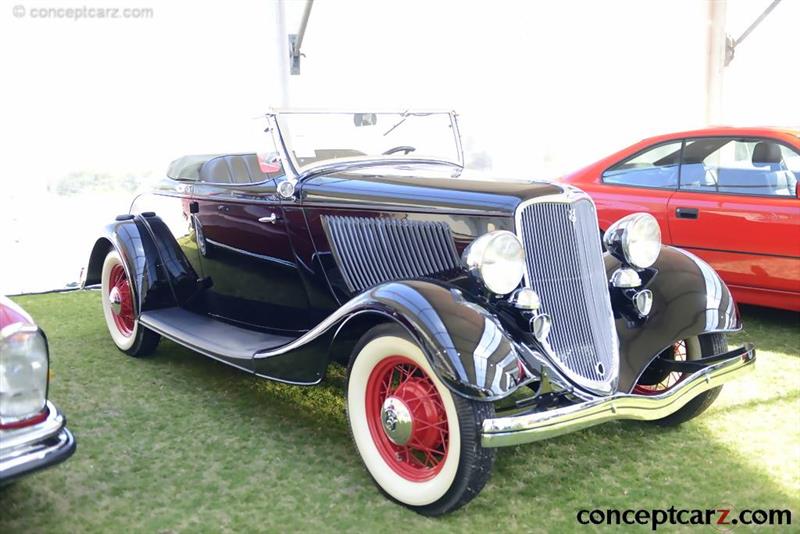1933 Ford Model 40 Navigation
Ford Motor Company's all-new model line introduced for 1932 enjoyed stunning success, with over 200,000 units sold during that year, and improvements for 1933 helped with the sales momentum. Both the 1932 and 1933 Fords would provide the perfect canvas for the expression of the hot rodder's art, as the growing California car culture would redefine the very foundations of automotive styling and design, especially during the post-World War II era. 
Station Wagon
Chassis #: 18397590
Auction entries : 1On March 31st of 1932, Henry Ford announced his new V-8 automobile was ready. Production of the previous Model A had halted the previous August, as the automotive community eagerly awaited the arrival of the new Ford. The on-again, off-again Model A production has been fueled by rumors of the new V-8 model and the announcement of a new four-cylinder model, the Model B. Mr. Ford had initially wanted an eight in an 'X' configuration, not a V-8. Experimentation revealed that the lower cylinders fouled easily, and power output was disappointing. Years earlier, in 1929, Chevrolet had switched from a four to a six, which helped them surpass Ford in production during 1931. The gauntlet had been raised, and Ford raised the ante by two, in this case to a V-8. The X-8 was laid to rest, and a low-cost V-8 was the next project.Styling
Styling for the 1932 Ford bodywork is credited to Edsel Ford, 'Sheet Metal Joe' Galamb, and body supplier Briggs Manufacturing Company, whose staff included Ralph Roberts and John Tjaarda. Edsel oversaw the new cruciform double-drop chassis frame and the longer wheelbase (stretched half a foot to 112 inches) bestowed upon the 1933 Fords, while the all-new 1933 bodywork had a British connection. The Ford Motor Company, Ltd, had been operating in Britain since 1911 and its Model T had proven to be very popular, achieving a market penetration in the 1920s approaching 50 percent. In 1922, Herbert Austin introduced a small vehicle named the Austin Seven and its utilitarian features were quickly embraced by the British community, aided in no small measure by the fact that its small-bore 46 cubic inch engine was taxed at barely one third the rate for a Model T. The Model A had an even larger bore than the previous T, prompting Ford to develop the Model AF with a smaller bore engine. Due to the vehicle's disappointing performance, Ford's Managing Director in England, Sir Percival Perry, initiated the development of a small car to compete with Austin's Seven. It was called the Model Y (sometimes known as the 'Ford Eight,' the 'Ford 6 CV' in France, and the Ford Forito in Spain) and was the first Ford automobile specially designed for markets outside of the United States. Ford Britain, Ford SAF and Ford Germany produced the Model Y from 1932 to 1937. The stying was created by Ford's Dearborn studios, and a young designer named Eugene Turenne 'Bob' Gregorie recently hired at Lincoln. So successful were the designs that the draftsmen simply provide scaled-up blueprints for the new American Ford model line. Design features included flowing lines, a gracefully angled windshield profile, and a sloped grille whose silhouette suggested a heart shape. The doors were hinged at the rear, opening in 'suicide fashion,' and the curvaceous one-piece bumpers with a center-dip feature. The headlamps were mounted directly to the fenders, the hood had angled side louvers, and all body styles wore black fenders. The streamlined designs created by E.T. Gregorie were, no doubt, inspired by his past experience designing yachts for the Elco Corporation and at Cox and Stevens, a New York naval architecture firm. His fame in the automobile industry, however, had been gained while working at coachbuilders Brewster & Company. As the custom body business deteriorated, Gregorie was laid off in 1929. He found employment in Detroit where he was hired by Henry Crecelius, a former Brewster colleague who had become chief body engineer at Lincoln.Evolutionary upgrades made to the engine included new aluminum heads, 6.3 to 1 compression, and improved ignition and cooling systems. The 1932 engines had been rushed into production resulting in many experiencing piston and bearing failures, block cracking, and overheating. The upgrades for 1933 resolved many of these issues and the V-8 would continue to power Ford vehicles for the next 21 years. Engine
The 90-degree, L-head eight-cylinder engine displaced 221 cubic inches and had mechanical valve lifters, three main bearings, a Detroit Lubricator downdraft, single-barrel carburetor, and produced 75 horsepower at 3,800 RPM. It was backed by a three-speed sliding gear transmission with a single dry plate clutch with woven asbestos lining clutch. The 17-inch wire-spoke wheels with drop center rims were placed at all four corners concealing mechanical internal expanding brakes.Body Styles
Both Standard and Deluxe trim levels were available, with the Deluxe receiving a higher level of trim and interior accouterments. They had upscale upholstery and additional appointments like dual horns and cowl lamps. Prices ranged from $475 for the Standard two-door rumble seat roadster and rose to $640 for the station wagon. There were two different coupe styles, three-window and five-window, both with crank-down rear windows. Additional body styles included a victoria, phaeton, rumble seat cabriolet, a two-door sedan (Tudor), and four-door sedan (Fordor). The most popular 1933 body style was the Standard Tudor Sedan selling at $500 with 106,387 examples sold. The Deluxe Tudor SEdan at $550 was the second most popular body style with 48,233 units sold, followed by 45,443 examples for the Deluxe Fordor Sedan at $610. 31,797 examples of the 5-window Standard coupe were built, selling at $490, and 19,602 examples were Standard Fordor Sedans ($560). Both the Standard Roadster and the Cabriolet, both with rumble seats, proved to be very exclusive as just 126 and 232 examples were built, respectively. Selling at the top of the price spectrum, the Station Wagon found 1,654 willing buyers. The maple wood paneling on the wagon was all hand-built and coated with multiple coats of clear Polyurethane. The work was handled by Murray, builder of most of Ford's wagon bodies. Amos Northup was chief designer at Murray Corporation of America and had been tasked with creating many of the bodies for Lincoln and Packard, along with Ford's A400 and B400 convertible sedans. His work on the wagon involved creating a sloping A-pillar and teardrop shape for the front doors. As a result, the front doors became wider and the rears were narrower, and the roof received a slight slope at the front. Four-Cylinder Model 40
Along with Deluxe and Standard trim levels on the eight-cylinder Model 40, Ford also offered a four-cylinder version. The four- and eight-cylinder versions were identical, distinguished by the lack of V-8 trim identification on the versions with the smaller engine. Prices of the four-cylinder model ranged from $425 to $590. Its L-head 200.5 cubic-inch engine had three main bearings, mechanical valve lifters, 4.6:1 compression, and offered 50 horsepower (30 taxable horsepower). Both the four and the eight rested on a 112-inch wheelbase platform and had an overall length of 182.9-inches. The eight-cylinder model was far more popular with 304,948 units built compared to 7,560 of the four-cylinder version.
Cabriolet Roadster
Chassis #: 40216257
Auction entries : 1The world was suffering from the effects of the Great Depression during the early 1930s, forcing many companies out of business. The styling updates of the 1933 Fords, along with the refinements to its engine, resulted in a 44 percent increase over its 1932 sales. In the wake of the economic hardships and the lack of buying power by most consumers, Ford found a way to increase sales and regain market share.
by Daniel Vaughan | Apr 2022

Station Wagon
Chassis #: 18397590
Auction entries : 1
Styling for the 1932 Ford bodywork is credited to Edsel Ford, 'Sheet Metal Joe' Galamb, and body supplier Briggs Manufacturing Company, whose staff included Ralph Roberts and John Tjaarda. Edsel oversaw the new cruciform double-drop chassis frame and the longer wheelbase (stretched half a foot to 112 inches) bestowed upon the 1933 Fords, while the all-new 1933 bodywork had a British connection. The Ford Motor Company, Ltd, had been operating in Britain since 1911 and its Model T had proven to be very popular, achieving a market penetration in the 1920s approaching 50 percent. In 1922, Herbert Austin introduced a small vehicle named the Austin Seven and its utilitarian features were quickly embraced by the British community, aided in no small measure by the fact that its small-bore 46 cubic inch engine was taxed at barely one third the rate for a Model T. The Model A had an even larger bore than the previous T, prompting Ford to develop the Model AF with a smaller bore engine. Due to the vehicle's disappointing performance, Ford's Managing Director in England, Sir Percival Perry, initiated the development of a small car to compete with Austin's Seven. It was called the Model Y (sometimes known as the 'Ford Eight,' the 'Ford 6 CV' in France, and the Ford Forito in Spain) and was the first Ford automobile specially designed for markets outside of the United States. Ford Britain, Ford SAF and Ford Germany produced the Model Y from 1932 to 1937. The stying was created by Ford's Dearborn studios, and a young designer named Eugene Turenne 'Bob' Gregorie recently hired at Lincoln. So successful were the designs that the draftsmen simply provide scaled-up blueprints for the new American Ford model line. Design features included flowing lines, a gracefully angled windshield profile, and a sloped grille whose silhouette suggested a heart shape. The doors were hinged at the rear, opening in 'suicide fashion,' and the curvaceous one-piece bumpers with a center-dip feature. The headlamps were mounted directly to the fenders, the hood had angled side louvers, and all body styles wore black fenders. The streamlined designs created by E.T. Gregorie were, no doubt, inspired by his past experience designing yachts for the Elco Corporation and at Cox and Stevens, a New York naval architecture firm. His fame in the automobile industry, however, had been gained while working at coachbuilders Brewster & Company. As the custom body business deteriorated, Gregorie was laid off in 1929. He found employment in Detroit where he was hired by Henry Crecelius, a former Brewster colleague who had become chief body engineer at Lincoln.Evolutionary upgrades made to the engine included new aluminum heads, 6.3 to 1 compression, and improved ignition and cooling systems. The 1932 engines had been rushed into production resulting in many experiencing piston and bearing failures, block cracking, and overheating. The upgrades for 1933 resolved many of these issues and the V-8 would continue to power Ford vehicles for the next 21 years. Engine
The 90-degree, L-head eight-cylinder engine displaced 221 cubic inches and had mechanical valve lifters, three main bearings, a Detroit Lubricator downdraft, single-barrel carburetor, and produced 75 horsepower at 3,800 RPM. It was backed by a three-speed sliding gear transmission with a single dry plate clutch with woven asbestos lining clutch. The 17-inch wire-spoke wheels with drop center rims were placed at all four corners concealing mechanical internal expanding brakes.Body Styles
Both Standard and Deluxe trim levels were available, with the Deluxe receiving a higher level of trim and interior accouterments. They had upscale upholstery and additional appointments like dual horns and cowl lamps. Prices ranged from $475 for the Standard two-door rumble seat roadster and rose to $640 for the station wagon. There were two different coupe styles, three-window and five-window, both with crank-down rear windows. Additional body styles included a victoria, phaeton, rumble seat cabriolet, a two-door sedan (Tudor), and four-door sedan (Fordor). The most popular 1933 body style was the Standard Tudor Sedan selling at $500 with 106,387 examples sold. The Deluxe Tudor SEdan at $550 was the second most popular body style with 48,233 units sold, followed by 45,443 examples for the Deluxe Fordor Sedan at $610. 31,797 examples of the 5-window Standard coupe were built, selling at $490, and 19,602 examples were Standard Fordor Sedans ($560). Both the Standard Roadster and the Cabriolet, both with rumble seats, proved to be very exclusive as just 126 and 232 examples were built, respectively. Selling at the top of the price spectrum, the Station Wagon found 1,654 willing buyers. The maple wood paneling on the wagon was all hand-built and coated with multiple coats of clear Polyurethane. The work was handled by Murray, builder of most of Ford's wagon bodies. Amos Northup was chief designer at Murray Corporation of America and had been tasked with creating many of the bodies for Lincoln and Packard, along with Ford's A400 and B400 convertible sedans. His work on the wagon involved creating a sloping A-pillar and teardrop shape for the front doors. As a result, the front doors became wider and the rears were narrower, and the roof received a slight slope at the front. Four-Cylinder Model 40
Along with Deluxe and Standard trim levels on the eight-cylinder Model 40, Ford also offered a four-cylinder version. The four- and eight-cylinder versions were identical, distinguished by the lack of V-8 trim identification on the versions with the smaller engine. Prices of the four-cylinder model ranged from $425 to $590. Its L-head 200.5 cubic-inch engine had three main bearings, mechanical valve lifters, 4.6:1 compression, and offered 50 horsepower (30 taxable horsepower). Both the four and the eight rested on a 112-inch wheelbase platform and had an overall length of 182.9-inches. The eight-cylinder model was far more popular with 304,948 units built compared to 7,560 of the four-cylinder version.

Cabriolet Roadster
Chassis #: 40216257
Auction entries : 1
by Daniel Vaughan | Apr 2022
Related Reading : Ford Model 40 History
The Ford Model 40 V8 rode on a 112-inch wheelbase and rode on 17-inch wire spoke wheels. Power was from a 90-degree L-head V-8 engine that displaced 221 cubic-inches and produced 75 horsepower. The engine was mated to a three-speed sliding gear transmission with floor shift controls. They had an X-member double-drop frame and mechanical internal expanding brakes at all four corners. The design....
Continue Reading >>
Continue Reading >>
- 1933 Ford Model 40 Menu
- Article
- Image gallery
- Valuation
- Specifications
- Profiles
- Production figures
Ford
Similar Automakers
Similarly Sized Vehicles
from 1933
Similarly Priced Vehicles
1933 Ford Model 40 Vehicle Profiles
Recent Vehicle Additions
Performance and Specification Comparison
Price Comparison
Model 40 Specification Comparison by Year
Year
Production
Wheelbase
Engine
Prices
Related Automotive News

All-New Ford Mustang Redefines Driving Freedom With Immersive Digital Cockpit, Advanced Engines and Bold Style
Nearly 60 years after its debut, the all-new, seventh-generation Ford Mustang is the most exhilarating and fun-to-drive yet, thanks to a completely reimagined driving experience
Immersive digital cockpit inspired by fighter jets features two large...

All-New Mazda MX-5 RF Named Best Sports Car At The 2017 Carbuyer Best Car Awards
The all-new Mazda MX-5 RF is named Best Sports Car by Carbuyer.co.uk
Available from £22,295 on-the-road, the all-new Mazda MX-5 RF features 1.5 and 2.0-litre engines.
Carbuyer Best Car Awards given in categories that match most popular search term...

Hyundai Announces 2018 Elantra GT Pricing
Standard Eight-inch Display Audio System with Apple CarPlay And Android Auto Integration
Standard Rearview Camera with Dynamic Guidelines
HIGHLIGHTS FOR THE 2018 ELANTRA GT
Lower and wider stance
European styling
Nearly 25 cubi...

THE McLAREN F1
FOR THE DRIVER VITALLY – AS IN ONE OF McLARENS WORLD CHAMPION RACING CARS – DRIVER AND VEHICLE BECOME ENTIRELY AS ONE
The primary design consideration for the McLaren F1 has been to make it without reserve a drivers car, an extremely high-performance...

RAM TRUCK TO SHOWCASE OFF-ROAD TRUCK LEADERSHIP AT 2016 OVERLAND EXPO
Overland Expo to host Ram Truck press conference and owner clinic
Fresh off their Chicago Auto Show unveiling, new 2017 Ram Power Wagon and Ram 2500 4x4 Off-road pickups will make their first Arizona appearance at the Overland Expo in Mormon Lake,...





























